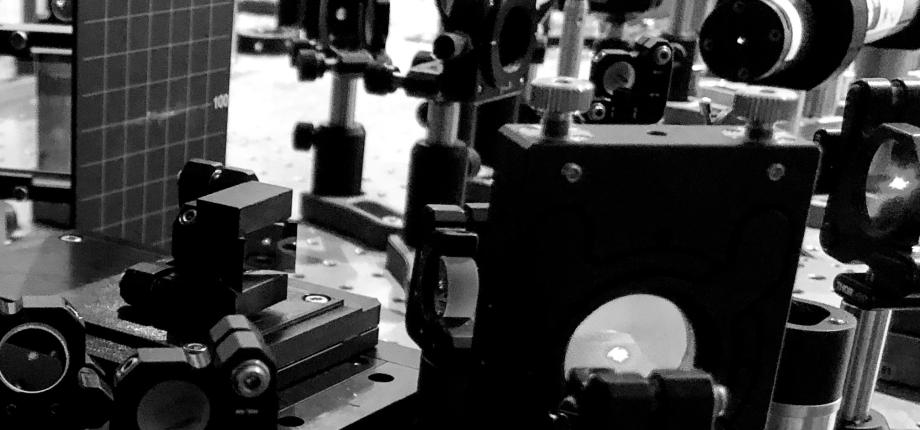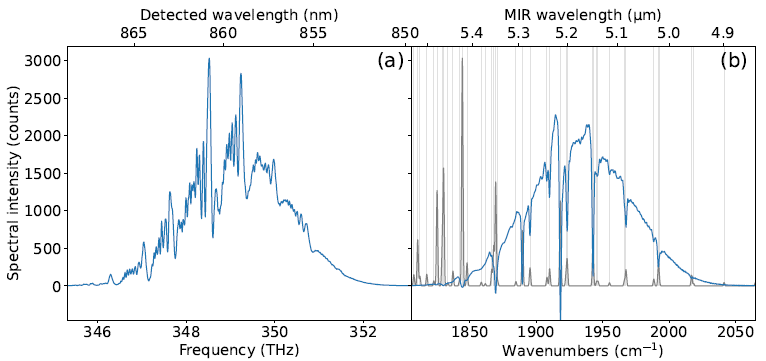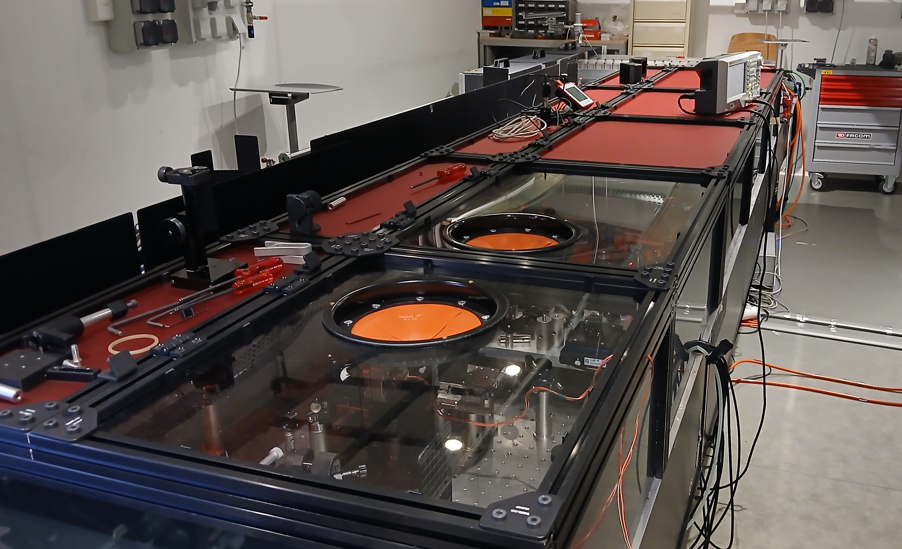MIRThyX

Femtosecond 2D Spectroscopy in the Mid-Infrared of Flavoenzymes by intrapulse Difference Frequency Generation at 100 kHz
ANR 19-CE30-0001 (10/2019 - 03/2024)
Project
Due to its sensitivity to ultrafast fluctuations and to couplings between vibrational modes, two-dimensional infrared (2DIR) spectroscopy has provided over the last twenty years a wealth of information on chemical and biochemical reactions. In parallel, recent progress in biotechnology now allow the insertion of unnatural amino acids at specific sites of proteins. As some of these unnatural amino acids can serve as local vibrational probes, their association with 2DIR spectroscopy can bring combined spatial and temporal resolution to the investigation of protein conformational dynamics. However, the development of this emerging approach has been hindered by signal-to-noise and data throughput limitations associated with current 2DIR spectrometers, most often based on 1-10 kHz Titanium:Sapphire femtosecond amplifiers. The aim of the MIRThyX project is to address this technical barrier by developing a new-generation 2DIR spectrometer that will take advantage of the recent advent of diode-pumped ultrashort lasers, and to apply this new instrument to the investigation of the structural dynamics of the flavoenzyme ThyX. The project is carried out by three partners: two academic partners, Laboratoire d’Optique et Biosciences (LOB) and Laboratoire Charles Fabry (LCF) and one industrial partner, Amplitude. The remarkable complementarity of the partners thus covers the broad range of skills needed for undertaking this interdisciplinary project, involving laser technology, mid-infrared (MIR) pulse generation and characterization, 2DIR spectroscopy and biochemistry.

A great asset of the MIRThyX project is a recent breakthrough, published in early 2019 by two of the partners (LCF and AS), consisting in the efficient temporal compression down to 7 fs of 300-fs pulses delivered by an Ytterbium Doped Fiber Amplifier. The spectral bandwidth of the high-energy pulses thus achieved is sufficiently broad to directly generate MIR pulses by intra-pulse Difference Frequency Generation. This approach will enable the generation of MIR pulses in a straightforward, single-beam arrangement at a repetition rate of 125 kHz, which is optimal for equilibrium 2DIR spectroscopy. This MIR femtosecond source will then be combined with a compact and fast-scanning interferometer associated with a Chirped-Pulse Up-conversion detection stage, resulting in excellent resolution in both pump and probe dimensions. The resulting 2DIR spectrometer, of unprecedented signal-to-noise ratio, spectral bandwidth and spectral resolution, will be demonstrated with the investigation of the structural dynamics of flavoenzyme ThyX, a bacterial alternative to Thymidylate Synthase, whose purpose is to produce the nucleotide associated with the letter T in DNA. Flavoenzyme ThyX being present in many pathogenic bacteria, while being absent in humans, it constitutes a promising antimicrobial target. In association with molecular dynamics simulations, multidimensional spectroscopy will help us understanding how some substrates or inhibitors act on structure fluctuations at different sites of interest determined by the chosen location of our vibrational probe. Our research might thus contribute to the optimization of new inhibitors. Beyond its scientific impact on 2DIR spectroscopy in proteins, the MIRThyX project will also result in a series of instrumental developments in terms of MIR pulse generation, characterization and application to 2DIR spectroscopy. The participation of the industrial partner will thus be essential, not only in the development of the MIR source itself but also to facilitate possible commercial development of the innovative instruments that will be designed during the project.
Results
We have developed two tunable MIR sources, the first one running at 250 kHz based on intra-pulse difference frequency generation [1-4], and the second one running at 100 kHz and based on difference frequency generation [3]. The graph below shows the spectra obtained using both sources.
We have extended the Chirped-Pulse Up-conversion (CPU) method, previously demonstrated with Ti:Sa femtosecond amplifiers at 1 kHz, to these new high-repetition rate MIR sources [5]. Thanks to the use of a fast CMOS linear camera, the up-converted spectra could be measured individually at the repetition rate of the laser, here 100 kHz. The figure below shows the spectrum corresponding to a single pulse (a). After suitable Fourier processing the effects of cross-phase modulation can be removed, yielding a corrected spectrum (b) with a spectral resolution of 1 cm-1, as evidenced by the narrow absorption lines resulting from water-vapor absorption.

Using the MIR source and CPU detection discussed above, we have developed a 2DIR spectrometer using the setup schematized below. The two-pulse pump sequence is generated by a Mach-Zehnder interferometer, with a delay scanning frequency of about 2 Hz. For each laser pulse, the probe pulse is measured as well as the interference signal from a He:Ne tracer beam, allowing accurate determination of the time delay between the two pump pulses. The measured probe pulse is then accumulated in the appropriate time bin.

The graph below shows the 2DIR spectra obtained in carboxy-hemoglobin after Fourier transform with respect to the time delay between the two pump pulses. The raw data (a) shows detrimental oscillations resulting from coherent pump scattering. However, this effect can be mitigated by dithering the pump-probe delay using the piezoelectric actuator (pzt) shown in the above figure. The 2DIR spectrum thus obtained (b) evidences the expected elongation along the diagonal, tending to a more circular shaped (c) when increasing the waiting time [6].

Work is currently in progress in order to apply this 2DIR spectrometer to azido-ThyX.
Publications
[1] Q. Bournet, F. Guichard, M. Natile, Y. Zaouter, M. Joffre, A. Bonvalet, I. Pupeza, C. Hofer, F. Druon, M. Hanna, P. Georges, Enhanced intrapulse difference frequency generation in the mid-infrared by a spectrally dependent polarization state, Opt. Lett. 47, 261 (2022).
[2] Q. Bournet, M. Jonušas, A. Zheng, F. Guichard, M. Natile, Y. Zaouter, M. Joffre, A. Bonvalet, F. Druon, Marc Hanna, P. Georges, Inline amplification of mid-infrared intrapulse difference frequency generation, Opt. Lett. 47, 4885 (2022).
[3] Q. Bournet, M. Natile, M. Jonušas, F. Guichard, Y. Zaouter, M. Joffre, A. Bonvalet, F. Druon, M. Hanna, P. Georges, Intensity noise in difference frequency generation-based tunable femtosecond MIR sources, Opt. Expr. 31, 12693 (2023).
[4] Q. Bournet, M. Jonušas, A. Zheng, F. Guichard, M. Natile, Y. Zaouter, M. Joffre, A. Bonvalet, F. Druon, M. Hanna, P. Georges, Maximizing the efficiency of intrapulse difference frequency generation by pulse shaping and recycling, Appl. Phys. B 130, 33 (2024).
[5] M. Jonušas, Q. Bournet, A. Bonvalet, M. Natile, F. Guichard, Y. Zaouter, P. Georges, F. Druon, M. Hanna, M. Joffre, Chirped pulse upconversion for femtosecond mid-infrared spectroscopy at 100 kHz, Opt. Express 32, 8020 (2024).
[6] M. Jonušas, Q. Bournet, A. Bonvalet, M. Natile, F. Guichard, Y. Zaouter, P. Georges, F. Druon, M. Hanna, M. Joffre, Two-dimensional infrared spectroscopy using chirped pulse up-conversion at 100 kHz, 11th international conference on coherent multidimensional spectroscopy (CMDS), York (2024).v





